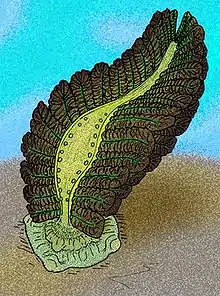Bomakellia
Bomakellia kelleri is an Ediacaran fossil organism represented by only one specimen approximately 9 cm long from the Ust'-Pinega Formation of the Syuzma River and it has similarity to Mialsemia semichatovi from the Yorga Formation of the Ediacaran (Vendian) siliciclastic sediments exposed on the Zimnie Gory locality, White Sea of northern Russia and these rocks are dated 555 million year old.

| Bomakellia Temporal range: | |
|---|---|
 | |
| Bomakellia kelleri, restored as a rangeomorph | |
| Scientific classification | |
| Kingdom: | Animalia |
| Phylum: | †Petalonamae |
| Family: | †Charniidae |
| Genus: | †Bomakellia Fedonkin, 1990 |
| Species: | †B. kelleri |
| Binomial name | |
| †Bomakellia kelleri Fedonkin, 1985[1] | |
Originally, B. kelleri was classified as being in probablematic Arthropod Class "Paratrilobita" , and was classified by Mikhail A. Fedonkin."[1] Indeed, a study by B. M. Waggoner even concluded that Bomakellia was a primitive anomalocarid He went on to identify ridges in the cephalon as being eyes, making this creature the earliest known animal with eye sight.[2] But this hypothesis has not reached acceptance, nor acknowledgement.[3][4]
A closer examination of the specimen has identified a tetraradial symmetry in the body, and a frond-like morphology which closely resembles that of Rangea – the current interpretation of Bomakellia is as a rangeomorph frond, which could possibly mean that it's closely related to the Chinese Paracharnia.[5]
References
- M. A. Fedonkin (1985). "Systematic Description of Vendian Metazoa". Vendian System: Historical–Geological and Paleontological Foundation. Moscow: Nauka. 1: Paleontology: 70–106.
- B. M. Waggoner (1996). "Phylogenic Hypotheses of the Relationships of Arthropods to Precambrian and Cambrian Problematic Fossil Taxa". Systematic Biology. Systematic Biology, Vol. 45, No. 2. 45 (2): 280–293. doi:10.2307/2413615. JSTOR 2413615.
- McMenamin, Mark A. S. (1998). The Garden of Ediacara. New York: Columbia University Press. ISBN 978-0-231-10559-0.
- Fryer, G. (1999). "Cambrian animals: evolutionary curiosities or the crucible of creation?". Hydrobiologia. 403: 1–11. doi:10.1023/A:1003799411987. S2CID 21020029.
- Dzik, J. (2002). "Possible ctenophoran affinities of the precambrian "sea-pen" Rangea". Journal of Morphology. 252 (3): 315–334. doi:10.1002/jmor.1108. PMID 11948678. S2CID 22844283.